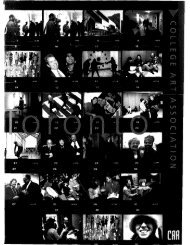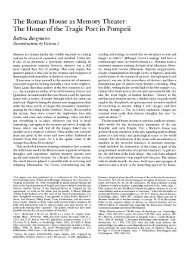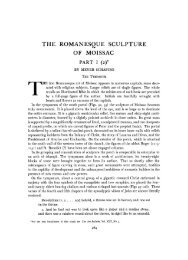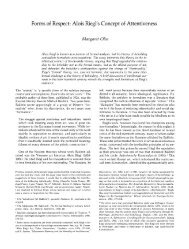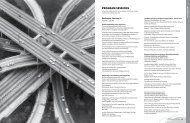THE HUMANISTIC THEORY OF PAINTING - College Art Association
THE HUMANISTIC THEORY OF PAINTING - College Art Association
THE HUMANISTIC THEORY OF PAINTING - College Art Association
Create successful ePaper yourself
Turn your PDF publications into a flip-book with our unique Google optimized e-Paper software.
UT PICTURA POESIS: <strong>HUMANISTIC</strong> <strong>THE</strong>ORY <strong>OF</strong> <strong>PAINTING</strong> 233<br />
from the dead now decrepit and bald, now young, in fact of every age, when it is written<br />
that on the last day there shall be no age nor youth, nor any deformity of body;'67 or the<br />
Virgin turns away from Christ, as if fearing that she herself were unprotected from his<br />
wrath;'68 or Charon's bark appears without the sanction of historical truth even though<br />
Michelangelo owed its introduction to the greatest of Italian poets.'69 For poetry and<br />
theology, says Gilio, are sharply opposed, and when Michelangelo painted an important<br />
article of the faith, it was his business to imitate the theologians, not the poets."'<br />
Gilio had, however, no objection to the poets provided the painter chose the proper<br />
moment to use them. And in the categorizing manner of his age he divides painters into<br />
three groups-poetical, historical, and mixed painters.17 The first are like the poets in being<br />
free to invent their subjects provided they follow Horace's advice to follow nature and avoid<br />
the incongruous, whereas the second group, as we have seen, are not free to invent at all,172<br />
at least if one includes in a definition of invention any imaginative treatment of one's reli-<br />
gious or historical subject. The third group, who have much in common, says Gilio, with<br />
the great epic poets of antiquity, mix fact with fiction in a delightful manner as Virgil did,<br />
for instance, when he added the purely fabulous account of Aeneas' sojourn with Dido to<br />
a story which in the main was historically correct.'7 And it is in the domain of allegory and<br />
symbolism where fact and fancy frequently mingle that the painters owe much to the<br />
antique poets, and even more to those sculptors who carved on the Roman triumphal arches<br />
personifications of Victory, Peace, and the City of Rome, whence the Christians learned to<br />
give human form to the theological virtues.'74 These are admitted in sacred art, Gilio<br />
characteristically adds, "for no other reason than because they are virtues, for the purity<br />
of religion wants nothing but what is virtuous, especially when it comes to allegorical<br />
figures."'" There follows a warning to the painters that recalls the later sentiments of<br />
De Piles and Du Bos that the spectator must be able to understand these mixtures of truth<br />
and fiction without undue mental effort.'76 And it is worth noting that Gilio's threefold<br />
division of poetical, historical, and mixed painters has its later counterpart in the threefold<br />
activity already discussed which F6libien was to assign to the grand peintre of the seven-<br />
teenth century.<br />
167. Ibid., p. 107: "L'altro capriccio ? [by capriccio<br />
Gilio means Michelangelo's "caprice," his unwarranted<br />
freedom of imagination which results in the violation of<br />
sacred truth], che in quel giorno non ci sara ne vecchiezza,<br />
ne pueritia, ne calvitie, ne cosa alcuna che renda il corpo<br />
in qual si voglia parte difforme, e brutto, come dianzi vi<br />
dissi: e quivi si veggono decrepiti, calvi, fanciulli, e gente<br />
d'ogni etade."<br />
168. Ibid., p. 107. It is argued that on the last day, far<br />
from fulfilling her role of intercessor for humanity, she will<br />
condemn with her son. But Michelangelo is finally al-<br />
lowed to be in the realm of "fintioni concesse" when he<br />
renders the Virgin as she turns away from Christ, only<br />
because he thereby shows the ignorant that she is (when<br />
not assisting at the Last Judgment) the Mother of Mercy.<br />
169. Ibid., p. io8. Gilio fears that the ignorant will be-<br />
lieve in the reality of poetic inventions: "L'altra cosa che<br />
mi dispiace ? che in uno articolo di tanta importanza<br />
Michelagnolo haggia framessa la favola di Caronte, che<br />
con la sua alata barca passa l'anime de'dannati, per la<br />
Stigia Palude; alzando il remo per batter quelle che<br />
tardano ad entrare dentro, accib dieno luogo a l'altre.<br />
Pensate voi che gli ignoranti non credano fermamente,<br />
che laggihi vi sieno fiumi, paludi, navi, giudici che rivedano<br />
i processi, el Cane da tre Teste che riscuote la gabella?"<br />
170. Ibid., p. og9: "Perb Michelagnolo dovendo<br />
dipingere uno articolo de la nostra fede importantissimo<br />
doveva imitare i Teologi, e non i Poeti, che la Teologia, e<br />
la poesia si sono de diretto contrarie."<br />
171. Ibid., p. 75: "Perche doverebbono sapere, che il<br />
pittore a le volte 6 puro historico, ' le volte puro poeta, ed<br />
a le volte ? misto. Quando 6 puro poeta, penso che lecito<br />
gli sia dipingere tutto quello, che il capriccio gli detta; con<br />
quei gesti, con quei sforzi sieno perb convenevoli a la figura,<br />
che egli fa." In the course of the next two pages Gilio<br />
translates a number of lines from the famous beginning of<br />
the Ars poetica in which Horace remarks that poets and<br />
painters have always had liberty of imagination, but that<br />
poets-and Gilio means that these lines shall apply as well<br />
to painters-must not make savage mate with tame, or<br />
serpents with birds, etc. (see note 14).<br />
172. There were very rare "fintioni concesse," but only,<br />
it would seem, if these could be construed to have some<br />
bearing of their own on theological truth. See note 168.<br />
173. Ibid., p. 116.<br />
174. Ibid., p. II17.<br />
175. Ibid.: "Perb i Cristiani da questi esempi mossi<br />
hanno imparato a dar forma humana a la Religione, a la<br />
Fede, a la Speranza, a la Carita, ed a l'altre virth che<br />
insieme con queste vanno mescolatamente con le cose sacre,<br />
e virth Teologiche si chiamano; e non per altro fra le<br />
cose sacre si mettono, che per esser virth, come che la<br />
purita de la religione altro che cose virtuose non richieda,<br />
e spetialmente queste."<br />
176. See p. 216 and note 86.



